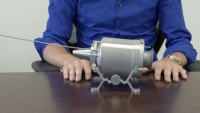3D Printing Technology Successfully Separated Conjoined Twins in China
| Eana Maniebo | | Jun 11, 2015 10:06 AM EDT |
(Photo : Reuters) Chinese doctor Liu Zhongjun poses for pictures with a spine model implanted with a 3D-printed artificial axis, at Peking University Third Hospital in Beijing. Whether it is a prosthetic limb or a part of a skull, 3D printing always presents a huge chance of survival for the patients.
The medical industry is indeed experiencing a surge of 3D printing related breakthroughs. Lives have been saved thanks to the second chances presented by 3D printed titanium implants and related technologies. 3D printing is yet to turn another irreparable case into a success story and historical moment in medicine, as what it's expected to accomplish in a complex surgery that aims to separate conjoined twins in China.
Like Us on Facebook
Whether it is a prosthetic limb or a part of a skull, 3D printing always presents a huge chance of survival for the patients. In February, a complex surgery to separate conjoined twins using a 3D printed model took place in Texas. The surgery involved using a 3D printed model to help surgeons oversee the twins' delicate set of organs using the knife. A similar technique will now be applied by Chinese doctors for an elaborate surgery intended for baby girls who are conjoined in the buttocks area.
Born on March 17 in South Fujian, Nanjing County, the conjoined twins shared the same digestive tract and portions of their anus. Surgeons at the Children's Hospital of Fudan University wanted to wait until the twins were 3 months old and weighed 10 kilograms before performing the surgery (which was scheduled on June 9), since studies had confirmed that this was the best time to perform such a dangerous operation.
The Children's Hospital of Fudan University has a reputable success rate on operations involving conjoined twins, with 7 sets successfully separated. To aid the previous operations, surgeons used the twins' CT scan data to create an accurate 3D printed replica of the twins for the simulation of the surgery. The doctors used the replica for a mock surgery, allowing enough room for necessary revisions on their surgical plan.
The operation, like all procedures involving conjoined twins, would be risky and difficult. Zheng Shan, Fudan University's vice president, said that the condition of conjoined twins is a rare congenital malformation, with a chance of 1 in 50,000 to 1 in 200,000 happening. Most conjoined twins are connected at the chest and abdomen. Twins conjoined at the hip area, as in the case of the twin girls, is extremely rare in the world, and only happens for about 18 percent of conjoined babies.
Aside from 3D printed models, 3D printed titanium body parts are heavily applied in other surgeries, and its widespread use prompts a specialized demand for the metal. A steady supply for the medical sector will be secured by developing mines focusing on the resource, such as Chile's White Mountain Titanium Corporation (OTCQB: WMTM).
3D printing has paved the way for medical history once more, as this is the first time that a 3D printed replica has been used to aid a surgery for conjoined twins. The Children's Hospital of Fudan University has used 3D printed titanium implants in other operations before, but not in separating conjoined twins. If the operation becomes successful, it will be another medical milestone that is made possible by 3D printing.
Tags3D Print, 3D printing technology, 3d printing in medicine, conjoined twins, conjoined twins separated, titanium, titanium dioxide, White Mountain Titanium, Cerro Blanco, 3d applications, how 3d printing can help lives
©2015 Chinatopix All rights reserved. Do not reproduce without permission
EDITOR'S PICKS
-

Did the Trump administration just announce plans for a trade war with ‘hostile’ China and Russia?
-

US Senate passes Taiwan travel bill slammed by China
-

As Yan Sihong’s family grieves, here are other Chinese students who went missing abroad. Some have never been found
-

Beijing blasts Western critics who ‘smear China’ with the term sharp power
-

China Envoy Seeks to Defuse Tensions With U.S. as a Trade War Brews
-

Singapore's Deputy PM Provides Bitcoin Vote of Confidence Amid China's Blanket Bans
-

China warns investors over risks in overseas virtual currency trading
-

Chinese government most trustworthy: survey
-

Kashima Antlers On Course For Back-To-Back Titles
MOST POPULAR
LATEST NEWS
Zhou Yongkang: China's Former Security Chief Sentenced to Life in Prison

China's former Chief of the Ministry of Public Security, Zhou Yongkang, has been given a life sentence after he was found guilty of abusing his office, bribery and deliberately ... Full Article
TRENDING STORY

China Pork Prices Expected to Stabilize As The Supplies Recover

Elephone P9000 Smartphone is now on Sale on Amazon India

There's a Big Chance Cliffhangers Won't Still Be Resolved When Grey's Anatomy Season 13 Returns

Supreme Court Ruled on Samsung vs Apple Dispute for Patent Infringement

Microsoft Surface Pro 5 Rumors and Release Date: What is the Latest?














